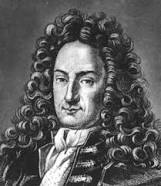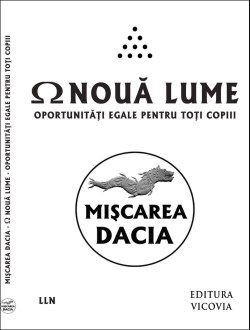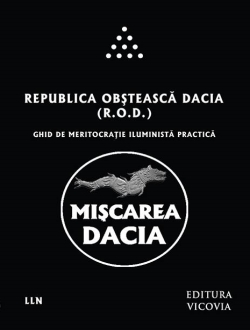 Vă invit să vă alăturaţi grupului Facebook Mişcarea DACIA, ce-şi propune un alt fel de a face politică!
Vă invit să vă alăturaţi grupului Facebook Mişcarea DACIA, ce-şi propune un alt fel de a face politică!Citiţi partea introductivă şi proiectul de Program, iar dacă vă place, veniţi cu noi !
O puteţi face clicând alături imaginea, sau acest link
Posts Tagged ‘Leibniz’
Hyperian History Of The World (18th Century, Part 1) – Leibniz –
Hyperian History Of The World (18th Century, Part 1)
The 17th Century had seen the rebirth of pure rational philosophy, primarily with Descartes and Spinoza, and had also seen the birth of modern science, with Galileo and, primarily, Isaac Newton. Both of these strains of human thought made significant diversions from the religious thinking which had dominated human thought for centuries prior, yet both of these new strains also differed from each other significantly.
The philosophy of Descartes and Spinoza was an expression of rationalism, the idea of deducing conclusions given certain basic principles. Science, however, was an expression of empiricism, of making observations of the world and producing theories to explain those observations. The key difference between these two approaches is that, in rationalism, if the basic principles are correct, the conclusions will absolutely be correct also, but in empiricism, the theories produced to explain the observations will only ever be theories which can never conclusively be proven to be true.
Given this, why was is that science became such a popular way of viewing reality, offering the greatest challenge to religion right up to the present day? The answer was, simply, that science appeared to be more rigorous than philosophy. Philosophy seemed, on the surface, to be mere speculation and, to those who were not natural rational thinkers, it was difficult to see the truth in what was being asserted about reality. Science, on the other hand, had, thanks to Newton, a key weapon up its sleeve – Mathematics. Newton didn’t make speculations about reality, rather, he wrote down specific mathematical formulae to explain his theories. This give science the appearance of being much more rigorous than philosophy and made it easier to understand for the majority of people. Of course, the use of mathematics by science was extremely ironic, given than science was empiricism and mathematics was the purest form of rationalism!
Of course, Descartes had been a great mathematician who understood the necessity of mathematical rigour to any philosophy. However, the mathematics available at the time simply wasn’t advanced enough to truly express his philosophy. Newton, on the other hand, had no such trouble, given that his theories were far more simplistic and required only basic mathematics to express them. Newton became renowned the world over for his theories, yet, unbeknownst to most of the world, he had a great rival, one who began the process of mathematising rationalist philosophy and producing a system of mathematical philosophy which provided the actual truth of reality, rather than the mere approximations of Newton’s theories.
Newton’s rival was the german Gottfried Wilhelm Leibniz, the greatest rationalist of them all and perhaps the greatest genius in our entire history. It is a great tragedy that he is still so unknown to the majority of humanity, whilst Newton is taught to most schoolchildren. Leibniz had a remarkable ability to educate himself in anything he required to further his understanding, as well as the ability to discover all of the flaws in existing systems of philosophy and begin the process of correcting them.
Starting with Descartes’s definition of matter being extended, Leibniz followed the rationality of this definition and saw that matter could always be divided into smaller and smaller units. Anything extended can be split up and made smaller, so the question was, what was the ground state of extended matter? Where did it come from? This led Leibniz to the conclusion that extended matter must somehow be derived from unextended mind. Mind was unextended, therefore ‘units’ of mind could never be further divided, and Leibniz realised that this made them the true basic units of the universe, thereby giving primacy to mind over matter.
For Leibniz, mind and matter were indeed two separate substances, as Descartes had stated, but one was derived from the other, namely matter was derived from mind, thereby making mind the primary substance of the universe. Matter’s being extended didn’t necessarily make it different from mind, but it made it simply the extended form of mind. Leibniz had presented himself with a problem, however. Just as extended matter could always be divided, becoming smaller and smaller, so unextended mind would always be unextended no matter how much of it was added together. The question then was, how did matter come from mind? How did unextended things give rise to extended things? The answer, of course, as Leibniz realised, lay in mathematics.
Taking inspiration from Giordano Bruno, Leibniz envisaged the universe to be primarily made of ‘particles’ of mind called monads. Each monad was an unextended, dimensionless point and the universe constituted an infinite number of monads existing next to one another with no gaps between them. Just as Pythagoras had said, each of these monads was unique and could therefore by represented by a unique number and the universe could therefore be explained in terms of the mathematical relations between these numbers. Leibniz realised that the relations between monads were what gave rise to extended matter. The extension itself was the mathematics of the unextended monads.
This was essentially the same thing that Pythagoras had said, however, Leibniz went even further. Leibniz said that each monad was an unextended, dimensionless point taking up zero physical space. Leibniz was then able to expand this definition after exploring the mathematical nature of the number zero. Leibniz realised that zero actually contained all other numbers. If one adds together every number in existence the result is zero. All numbers, both positive and negative, real and imaginary, cancel to zero when added together. Leibniz therefore realised that each monad contained an infinite amount of mathematical energy, represented by all the possible numbers, which all cancelled down to zero, maintaining the zero value of the monad.
Monads, as units of mind, were, metaphysically speaking, all individual souls, or thinking minds, this thinking being the monad’s subjective experience of the mathematical activity of the energy contained within it. Just as an individual monad is the balance of the infinite energy contained within it, so the whole universe is a balance of the infinite energy of the infinite monads contained within it. The physical world is derived from the mathematical relations between the monads. Each monad performs mathematical operations which it experiences as thoughts. As the monad performs these operations, it begins to reflect on itself, learn about itself and the rest of the universe. Eventually, each monad realises its potential and achieves perfect mathematical balance, meaning that, subjectively, it will know the whole universe, i.e. it will have become God, become perfect.
Leibniz had in fact taught himself mathematics once he realised that it was the subject required to give rigour to his philosophy, saving it from the metaphysical nature of other rationalist philosophies. Once he had taught himself all the mathematics available at the time, an astonishing achievement in itself, Leibniz then realised that more mathematical developments had to be made in order to truly express his philosophy. The first major advancement in mathematics which Leibniz made, was Calculus, the branch of mathematics which basically explores change, extension and dimensions.
Unbeknownst to Leibniz, Isaac Newton had already devised a version of Calculus a few years before Leibniz published his work, although Newton hadn’t published his own work. This led to a dispute as to which of them had actually discovered Calculus, with even accusations of plagiarism being made. Although Newton definitely made the discovery first, his Calculus was difficult to understand, used strange notation and had no real philosophical point. The Calculus of Leibniz, however, had been derived specifically for his philosophical purposes, made far greater sense and used notation which has become the standard for mathematicians ever since.
Unfortunately, even for humanity’s greatest genius, the task of fully mathematicising his philosophy required far more advanced mathematics than even he was able to discover in his lifetime. Perhaps this is why his brilliant philosophy was all but ignored and forgotten by most, whereas Newton became studied the world over. Nonetheless, in 1714, Leibniz published his ‘Monadology’, an amazingly concise outline of his philosophy, although expressed in purely metaphysical terms rather than mathematical.
Perhaps still wary of the scrutiny of the church, or perhaps in an attempt to give his philosophy more relevance to the people of the time (for Leibniz was massively ahead of his time), Leibniz included elements in the Monadology which allow for various concepts which were acceptable to christianity, such as there being a supreme Monad superior to all others (i.e. god). Leibniz had introduced the principle of sufficient reason (PSR) early on in the text (“no fact can ever be true or existent, no statement correct, unless there is a sufficient reason why things are as they are and not otherwise”). If one carefully analyses the Monadology, one will find various points where Leibniz’s reasoning seems to ‘jump’ arriving at conclusions without giving sufficient reasons for them. Can humanity’s greatest genius really have made such errors? Or is there a hidden mystery to the Monadology? Perhaps Leibniz had in fact created a work which, on the surface, appeared to offer a metaphysical philosophy acceptable to christianity, but which, underneath the surface, was in fact a kind of logical puzzle, one which a true rationalist might solve in order to discover the real truth of reality. Be invoking the PSR at all times, one may be able to identify all of Leibniz’s ‘mistakes’ and then begin to ‘correct’ them, thereby bypassing the christian elements and arriving at the real truth of existence.
In 1716, two years after the publication of the Monadology, Leibniz died. His funeral was attended by his personal secretary and a few townsfolk who had known him and his grave went unmarked for 50 years. When Newton died in 1727, his body lay in state before being buried in Westminster Abbey and his funeral was attended by noblemen from across Europe, most of the fellows of the Royal Society and dozens of other mourners. A large monument was built near his grave which is still visited by tourists from all over the world today, while Leibniz goes all but forgotten.
Such was the fate of humanity’s greatest genius. Yet Hyperianism will see justice done, and Leibniz returned to his rightful place at the very pinnacle of human brilliance during the dark times of ignorance and faith. Leibniz wrote, “I have so many ideas that may perhaps be of some use in time if others more penetrating than I go deeply into them someday and join the beauty of their minds to the labour of mine.” As Hyperians, it is our duty to aspire to this great task.
Tags: Leibniz
Cheia Existenţei
„Cheia existenței se află în cele două cifre intim legate: Zero și Infinit. Monadologia lui Leibniz plasează Zero în centrul Existenței. Fiecare Monadă este un punct matematic fără dimensiuni care ocupă spațiul fizic Zero (de aici, o Monadă poate fi asimilată ontologic cu numărul Zero). Mai mult decât atât, fiecare Monadă are o capacitate infinită pe care o putem numi “Energie” sau capacitatea nesfârșită de a efectua Operații Matematice (ceea ce este cu adevărat Energia). Potrivit Matematicii Ontologice, numerele sunt arche – substanța fundamentală a existenței, și toate provin de la Zero, Monada.
Zero Ontologic, originea, conține toate celelalte Numere, adică zero ontologic în mod inerent cuprinde fiecare alt număr. Aceasta este una dintre definițiile-cheie ale Zero-ului Ontologic: este ceea ce acționează ca şi container pentru o infinitate de numere. Zero și Infinit sunt legate indisolubil în Matematica Ontologică. La fel ca și zero ontologic are o semnificație reală (în afară de a fi un container pentru toate celelalte numere, Zero este și un Punct Matematic și punctele matematice sunt baza Matematicii, deci a Realității însăși), astfel încât toate numerele au o semnificație reală.
În matematica ontologică, fiecare număr este de fapt un val sinusoidal (val sinus sau cosinus), cu numărul specificând frecvența undei, adică un Număr dpdv. ontologic, este o Frecvență a Undelor. Un val sinusoidal este realitatea ontologică a “energiei”. Energia mai mare înseamnă o frecvență mai mare, ceea ce înseamnă un număr mai mare. Fiecare număr este codificat în realitate ca o măsură a energiei. Numărul 12 poate părea o abstractizare, dar ontologic se referă la un val sinusoidal de frecvență de 12 unități (unde “unitățile” se referă comparativ la un val sinusoidal de frecvență 1, valul “de bază”). Toate numerele pot fi caracterizate ontologic ca valuri sinusoidale, iar toate combinațiile de numere sunt combinații ontologice ale unor astfel de valuri. Aşa construim un întreg Univers “făcut” din Numere, exact așa cum a afirmat Pitagora în fraza sa nemuritoare: “Toate Lucrurile Sunt Numere”. Ceea ce a vrut să spună în termeni mai puțin abstracţi este că toate numerele sunt valuri de energie.
Mulţumită descoperirilor sale muzicale, Pitagora a fost obsedat de Armonia Cosmică. El a fost descoperitorul faptului profund că înjumătățirea lungimii pe o coardă a unei Lire a generat o notă de o octavă mai mare. Cu alte cuvinte, relațiile dintre numere sunt codate fizic (muzical, prin unde sonore, ca în cazul unei lire). Anumite combinații bazate pe rapoarte de numere întregi sunt armonioase și prospere, în timp ce alte combinații sunt instabile și se estompează în dezacord și uitare. Aici vedem baza teoriei moderne a undelor (mecanica cuantică) și teoria corzilor (care este adesea descrisă în termeni de analogie muzicală).
Posedând o Minte Intuitivă Divină, Pitagora a înțeles că întregul univers era ca un sistem cosmic de muzică, ghidat de armonii și astfel a ajuns la conceptul său sublim al Muzicii Sferelor, orchestrația cosmică a Existenței. Sferele cele mai exterioare ale cosmosului se mișcă cel mai rapid și fac notele cele mai înalte, în timp ce sferele cele mai interioare care se mișcă încet furnizează notele mai joase. Raiul nu este altceva decât o Orchestră Matematică, sunând simfonia creată de compozitorul divin – Dumnezeu.”
– Illumination
29.03.2019

Tags: Adevăr, Armonie, Dezarmonie, Energie, Frecvenţe, Infinit, Leibniz, Matematica Ontologică, Monada, Muzica Sferelor, Numere, Pitagora, Zero
Despre MONADOLOGIA lui LEIBNIZ

„Fabrica de Dumnezeu”
În afară de stabilirea Principiilor Iluminării, ea analizează critic Teosofia, Madame Blavatsky, Antroposofia, Rudolf Steiner, Pierre Teilhard de Chardin, Noosphere, Omega Point, Spinoza, Scophenhauer, Kant, Neoplatonism, Henri Bergson și Elan Vital. Ea discută ideile unor astfel de mari Iluminiști precum Pitagora, Leibniz, Hegel, Nicholas de Cusa, Giordano Bruno, Jakob Boehme și Paracelsus.”

LEIBNIZ – Mare Maestru Illuminati
„Ultimul Om Care A Ştiut Totul
– Filosoful şi Matematicianul Wilhelm Leibniz 1646 – 1716
Cu trei sute de ani în urmă, era încă posibil ca o persoană inteligentă să fi citit toate cărțile care constituiau întreaga bază de cunoștințe a lumii.
Leibniz a fost ultimul geniu care a știut cu adevărat totul și a acceptat că universul era mai degrabă un Organism decât o Mașină. Un tip foarte special de Organism – un Organism Matematic.
Leibniz avea un alt motiv secret pentru a fi faimos: el era autorul „Marii Teorii A Întregului” a ILLUMINATI bazată pe purul „Nimic”. El a conceput un întreg Univers ca un “Big Bang” al unei Singularităţi şi care Univers, cuprinde infinite MONADE (zerouri), fiecare având o capacitate de Energie Infinită
.Aceasta este povestea primei Teorii Matematice a Întregului, care rămâne valabilă până astăzi ca adevărată explicație a Realităţii.
Monadele lui Leibniz au un ultim, incredibil Secret de dezvăluit: ele sunt de fapt Suflete!”
Nesvarbenskas Romas












